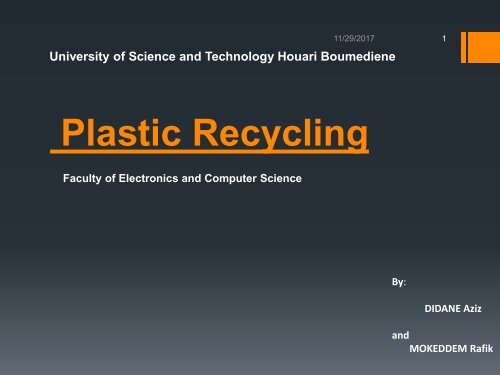Plastic-Recycling
Create successful ePaper yourself
Turn your PDF publications into a flip-book with our unique Google optimized e-Paper software.
University of Science and Technology Houari Boumediene<br />
1<br />
<strong>Plastic</strong> <strong>Recycling</strong><br />
Faculty of Electronics and Computer Science<br />
By:<br />
DIDANE Aziz<br />
and<br />
MOKEDDEM Rafik
I- Introduction:<br />
2<br />
• <strong>Plastic</strong> is among the most popular and important<br />
materials used in the modern world. The basic raw<br />
materials of plastic are petroleum and gas, we can<br />
optimize the lifespan of plastics by recycling and<br />
reusing them.<br />
• <strong>Plastic</strong> recycling refers to the process of recovering<br />
waste and scrap plastic and reprocessing it into useful<br />
product. But many plastic product is nonbiodegradable,<br />
it's necessary to protect and clean<br />
environment
Cycle of <strong>Plastic</strong> <strong>Recycling</strong><br />
3
II- <strong>Plastic</strong> recycling process:<br />
4<br />
• An item made out of plastic is recycled into a<br />
different product, which usually cannot be recycled<br />
again.<br />
• Before any plastic waste is recycled, it needs to go<br />
through different stages
1-Collection:<br />
5<br />
• <strong>Plastic</strong>s are available in a<br />
number of forms for example<br />
plastic containers, jars, bottles,<br />
plastic bags, packaging plastic.<br />
Due to their nature and<br />
availability. Tons of scrap<br />
plastic are collected and sent to<br />
a collecting yard where they<br />
are then packed and<br />
transported to plastic<br />
processing plants.<br />
Bottle Balls
2-Sorting:<br />
6<br />
• The actual plastic recycling process starts with sorting of the<br />
different plastic items by their resin content and color. There<br />
are specially designed machines that help in sorting of the<br />
plastics according to their resin content.<br />
• The sorting machine will emit in the near infrared, and then<br />
analyze the reflected wave to determine the material. As for<br />
the sorting of the color, it is done by camera
3-Shredding:<br />
7<br />
• After sorting the plastics, the next step is to cut the<br />
plastics into pieces. The plastic bottles and containers<br />
are then ground and cut into tiny pieces or flakes. The<br />
heavier and lighter plastic flakes are separated using a<br />
specially designed machine. The separation process<br />
helps in ensuring that the different plastics are not put<br />
together or mixed up in the final product.<br />
Remember that different<br />
plastics are used to make<br />
different items.
4-Cleaning:<br />
8<br />
• After a complete separation, the flakes or chunks<br />
are then washed with detergents to remove the<br />
remaining contamination.<br />
• The plastic flakes are then subjected to moderate<br />
heat to dry.<br />
• The company practices quality tests on flakes and<br />
if they are conclusive, they can be stored in silo.
5-Melting:<br />
• The dry flakes are melted down.<br />
They can be melted down and<br />
molded into a new shape or they<br />
are melted down and processed<br />
into granules as shown in the<br />
figure on the right.<br />
• The flakes are introduced into the<br />
extruder and heated therein. The<br />
plastic comes out of the extruder<br />
head in the form of monofilaments<br />
or wires that cool in contact with<br />
the water in the tank. The wires<br />
pass through the die where they<br />
are cut by a rotating blade. This<br />
process provides the correct grain<br />
or granulate required.<br />
<strong>Plastic</strong>s granulate<br />
9
III- Advantages of recycling<br />
plastics:<br />
10<br />
• <strong>Plastic</strong>s should be recycled because of a number of reasons<br />
as can be seen below:<br />
a)-Burden on the Environment:<br />
<strong>Plastic</strong> goods are useful because they are durable, but this becomes a<br />
disadvantage when items are discarded. In nature, plastic bits and<br />
pieces become unsightly nuisances and hazards to animals. When<br />
plastics are eliminated through recycling, the environment looks clean<br />
and inhabitable.
)-Provision of a Sustainable<br />
Source of Raw Materials:<br />
<strong>Recycling</strong> plastics provides a sustainable source of raw materials to the<br />
manufacturing industry. Once the plastics are recycled, they are sent to<br />
industries to be redesigned and converted into new shapes and used in<br />
different appliances.<br />
c)-Consumes Less Energy:<br />
<strong>Recycling</strong> plastic saves energy. The process of manufacturing plastic using<br />
natural raw materials is expensive and time consuming compared to the<br />
recycling process.<br />
d)-Reduces Landfill Problems:<br />
<strong>Recycling</strong> plastics minimizes the amount of plastic being taken to the<br />
ever diminishing landfill sites.<br />
Most countries have designated areas specifically meant for burying<br />
plastics. When they are recycled, these sites will receive little plastic<br />
garbage. The remaining areas can be used for other purposes.<br />
11
IV- Conclusion:<br />
12<br />
In conclusion, plastic industries offer considerable<br />
benefits for the future, but it is evident that our current<br />
approaches to production, use and disposal are not<br />
sustainable and present concerns for wildlife and human<br />
health.<br />
We have considerable knowledge about many of the<br />
environmental hazards, and information on human health<br />
effects is growing, but many concerns and uncertainties<br />
remain. There are solutions, but these can only be<br />
achieved by combined actions.
Thank you for your attention!<br />
13



